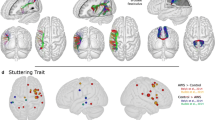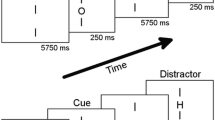Abstract
We report two patients, in whom stuttering evolved as an adverse effect of pallidal deep brain stimulation for treating dystonia. Speech dysfluency was observed under conditions that optimally suppressed dystonic symptoms without inducing other extrinsic stimulation effects. This emphasizes a role of the sensorimotor part of the internal globus pallidus in regulating speech fluency.
Similar content being viewed by others
References
Benke T, Hohenstein C, Poewe W, Butterworth B (2000) Repetitive speech phenomena in Parkinson’s disease. J Neurol Neurosurg Psychiatry 69:319–324
Burghaus L, Hilker R, Thiel A, Galldiks N, Lehnhardt Fg, Zaro-Weber O et al (2006) Deep brain stimulation of the subthalamic nucleus reversibly deteriorates stutering in advancesd Parkinson’s disease. J Neural Transm 113:625–631
Ciabarra AM, Elkind MS, Roberts JK, Marshall RS (2000) Subcortical infarction resulting in acquired stuttering. J Neurol Neurosurg Psychiatry 69:546–549
Helm-Estabrooks N, Hotz G (1998) Sudden onset of “stuttering” in an adult: neurogenic or psychogenic? Semin Speech Lang 19:23–29
Koller WC (1983) Dysfluency (stuttering) in extrapyramidal disease. Arch Neurol 40:175–177
Kupsch A, Benecke R, Müller J, Trottenberg T, Schneider GH, Poewe W et al (2006) Pallidal deep-brain stimulation in primary generalized or segmental dystonia. N Engl J Med 355:1978–1990
Ludlow CL, Rosenberg J, Salazar A, Grafman J, Smutok M (1987) Site of penetrating brain lesions causing chronic acquired stuttering. Ann Neurol 22:60–66
Ludlow CL, Loucks T (2003) Stuttering: a dynamic motor control disorder. J Fluency Disord 28:273–295 quiz 295
Van Borsel J, van der Made S, Santens P (2003) Thalamic stuttering: a distinct clinical entity? Brain Lang 85:185–189
Vidailhet M, Vercueil L, Houeto JL, Krystkowiak P, Benabid AL, Cornu P et al (2005) Bilateral deep-brain stimulation of the globus pallidus in primary generalized dystonia. N Engl J Med 352:459–467
Vidailhet M, Vercueil L, Houeto JL, Krystkowiak P, Benabid AL, Lagrange C et al (2006) Bilateral pallidal deep brain stimulation in primary generalized dystonia: a prospective controlled three-year follow-up study
Author information
Authors and Affiliations
Corresponding author
Electronic supplementary material
Below is the link to the electronic supplementary material.
Viedo Case 1 Segment 1 demonstrates the fluency of spontaneous speech and reading in the presence of severe torsion dystonia in patient 1 before surgery. Segment 2 presents severe stuttering during the interview with a speech therapist three years after initiating pallidal neurostimulation. Segment 3 Stuttering is not improved during a period of unilateral pallidal stimulation after fracture of the right extension cable, while contralateral dystonia worsened acutely. Video Case 2 Segment 4 presents the fluency of reading before surgery in patient 2 Segment 5 demonstrates the presence of marked stuttering one year after surgery during the interview with a speech therapist, while cervical dystonia is almost completely suppressed. (MPG 12108 kb)
Rights and permissions
About this article
Cite this article
Nebel, A., Reese, R., Deuschl, G. et al. Acquired stuttering after pallidal deep brain stimulation for dystonia. J Neural Transm 116, 167–169 (2009). https://doi.org/10.1007/s00702-008-0173-x
Received:
Accepted:
Published:
Issue Date:
DOI: https://doi.org/10.1007/s00702-008-0173-x




